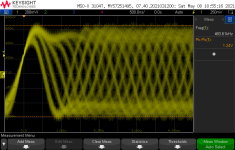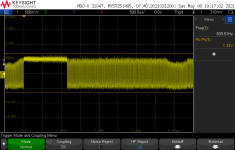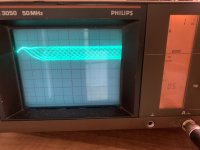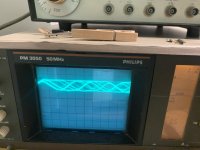With my CD 67 OSE, all I did was sticking some non smelly, heavy self sticking damping pad on the top of the cover. Anything else is just fine as is. I had quite a collection of Maranz CD player and it was the one I like best. Why? HADAM? I don't know. Just my ears that say so. There was a Marantz DVD player that came quite close to it, which was very surprising. DVD player are supposed to sound bad. It died quite young and I don't remember the model, but from the same time like the 67 OSE.
My cd63se does not play all cd’s.
Some play fine
Some read TOC but doesn’t play
Some does nog even read TOC
I haven’t discovered a pattern yet which play fine and which don’t.
Any ideas?
Some play fine
Some read TOC but doesn’t play
Some does nog even read TOC
I haven’t discovered a pattern yet which play fine and which don’t.
Any ideas?
And also look at the pattern to see if it is clear, steady amplitude with low jitter (horizontal waving). Look for the RF test point, or it may say "eye". Otherwise you'll have to go hunting for it near the RF amp chip. I can't remember on this player specifically.Measure the amplitude of the eye pattern.
There are a lot of poor quality CDs out there.
CD-43 should be the same family as 63:Look for the RF test point, or it may say "eye".
Fortunately the gain of the amplifier stage is tweakable (unless the laser is completely bust).
Simulated a bit before doing the changes...
Attachments
Last edited:
It may be even simpler than that - old, dried out grease on the rods the laser head tracks on can cause read errors like this. They start randomly but get worse until all disks fail to read - take the transport out, clean and relube the rods and gears, then see if you need to adjust the eye pattern.
This can be done even without taking the transport out.take the transport out, clean and relube the rods and gears,
Great, thanks.
The drawn pattern isn't very good. It is showing double lines where there should be single lines.
The first pic is a decent eye pattern, but off a DSO, an analogue scope would show a much cleaner pattern. The second is E-F balance set correctly using Pierre Verany test CD #2. This is a much better / finer setting than what you would see in a service manual. This is the RF recovery after an interruption. You can see the scope settings on the top. The recovery waveform is tricky and requires coupling and trigger level changes (= a pain).
The drawn pattern isn't very good. It is showing double lines where there should be single lines.
The first pic is a decent eye pattern, but off a DSO, an analogue scope would show a much cleaner pattern. The second is E-F balance set correctly using Pierre Verany test CD #2. This is a much better / finer setting than what you would see in a service manual. This is the RF recovery after an interruption. You can see the scope settings on the top. The recovery waveform is tricky and requires coupling and trigger level changes (= a pain).
Attachments
Thanks I’ll start with this as the drawer also pulls out sloowly. May be a general grease issue.It may be even simpler than that - old, dried out grease on the rods the laser head tracks on can cause read errors like this. They start randomly but get worse until all disks fail to read - take the transport out, clean and relube the rods and gears, then see if you need to adjust the eye pattern.
Right… greasing the wheels didn’t help much. I noticed by the way that the non playing disc(s) would play the final tracks of the album (like track 15-17 of 17). So I suspected the tracking motor/mechanism and greased that. No luck.
Then I measured the eye pattern, indeed on the discs that don’t play well, the pattern seems clipped/intermittent. On the discs that do play well, there is a wobble synchronously to the disc rotation. Hence I suspected the spindle motor.
I couldn’t find a hole to grease the bearing of the spindle motor but then remembered I have a spare cdm12 laser assemble, and put that one in (ie replaced the laser and the splindle and tracking motor).
Result: same symptoms (now even the final tracks of the same disc don’t play anymore, but the discs that were fine before still play).
So assuming something beyond the laser/motors…. Ideas?
Then I measured the eye pattern, indeed on the discs that don’t play well, the pattern seems clipped/intermittent. On the discs that do play well, there is a wobble synchronously to the disc rotation. Hence I suspected the spindle motor.
I couldn’t find a hole to grease the bearing of the spindle motor but then remembered I have a spare cdm12 laser assemble, and put that one in (ie replaced the laser and the splindle and tracking motor).
Result: same symptoms (now even the final tracks of the same disc don’t play anymore, but the discs that were fine before still play).
So assuming something beyond the laser/motors…. Ideas?
Hi studiostevus,
Please post a picture of a "good" eye pattern. What is the amplitude and how does that compare to the "bad" discs? A picture of that wouldn't hurt.
Is the amplitude increasing and decreasing, do you have horizontal waving (time axis)? Remember, on my bench it is easy to figure out, it isn't on my bench. The same for others here, we can only go on what you tell / show us. What you say make form the basis of assumptions we have to make, so please be accurate.
Please post a picture of a "good" eye pattern. What is the amplitude and how does that compare to the "bad" discs? A picture of that wouldn't hurt.
Is the amplitude increasing and decreasing, do you have horizontal waving (time axis)? Remember, on my bench it is easy to figure out, it isn't on my bench. The same for others here, we can only go on what you tell / show us. What you say make form the basis of assumptions we have to make, so please be accurate.
The best way to repair a CD player usually is to replace the whole drive unit, including laser and motor. Simpler than changing just the laser and often only 2-5$ more for the whole drive.
There is one problem. The new drive may not come with the same pulley the old one had, or it may not be at the same height.
So when a CD is inserted, the upper part of the clamping mechanism will not fit or be unable to release the CD when eject is pushed. The upper part of the clamp, sitting loosely on a bridge, magnetically presses on the CD and prevents it from splipping.
The pulley is pressed on the spindle of the motor and often is impossible to move or remove. It is in most cases also impossible to remove the motor from the drive assembly with the pulley on the axle.
In such a case you still can remove the new laser form the assemby and fit it into the old one.
There are also some ways to modify the pulley, if you carefully analyse the problem. In one case a 4mm rubber ring, placed over the end of the axle, inside the pulley, prevented the upper part to jam, making it impossible for the motor to open the tray.
Sometimes, if the clamp doesn't close and the CD is slipping on start up, carefully removing some material can help. This is uncritical, as long as the CD centering part is not touched.
I have repaired countless CD player and not one had a problem with electronics. This is not true for DVD player, here more often the laser lasts and some unrepairable electronic part fails.
There is one problem. The new drive may not come with the same pulley the old one had, or it may not be at the same height.
So when a CD is inserted, the upper part of the clamping mechanism will not fit or be unable to release the CD when eject is pushed. The upper part of the clamp, sitting loosely on a bridge, magnetically presses on the CD and prevents it from splipping.
The pulley is pressed on the spindle of the motor and often is impossible to move or remove. It is in most cases also impossible to remove the motor from the drive assembly with the pulley on the axle.
In such a case you still can remove the new laser form the assemby and fit it into the old one.
There are also some ways to modify the pulley, if you carefully analyse the problem. In one case a 4mm rubber ring, placed over the end of the axle, inside the pulley, prevented the upper part to jam, making it impossible for the motor to open the tray.
Sometimes, if the clamp doesn't close and the CD is slipping on start up, carefully removing some material can help. This is uncritical, as long as the CD centering part is not touched.
I have repaired countless CD player and not one had a problem with electronics. This is not true for DVD player, here more often the laser lasts and some unrepairable electronic part fails.
This is what I see. First the scope pattern playing a functioning disc. Second a non functioning disc (trying to read TOC, giving up after 2 seconds)Hi studiostevus,
Please post a picture of a "good" eye pattern. What is the amplitude and how does that compare to the "bad" discs? A picture of that wouldn't hurt.
Is the amplitude increasing and decreasing, do you have horizontal waving (time axis)? Remember, on my bench it is easy to figure out, it isn't on my bench. The same for others here, we can only go on what you tell / show us. What you say make form the basis of assumptions we have to make, so please be accurate.
Attachments
What measuring points did you use for getting these images? And what is the P2P voltage?This is what I see.
THat's a really nice scope! Keep it! I also have a PM3070 and a PM3365A. Probably the best I have ever had for eye patterns.
From experience, neither eye patterns look good.
From experience, neither eye patterns look good.
He's on the 1 V/div vertical, 0.5 uSec horizontal, the display to the right of the screen. He should be on 0.5 V/div to make it more clear.
Hi Turbowatch2,
For a Philips CDM, this is normally the only way. Alignment of the swing arm is really factory only and involves a clear glass CD (expensive as sin!). I've tried the procedure, as has Revox Canada.
Normally the disc motor is bad, or the turntable has slipped down the shaft. Beyond that, new mech. The newer VAM transports are pure garbage.
There are some capacitors on the RF amp PCB that can go open, same for the servo PCB. Always watch for top to bottom PCB connections.
For a Philips CDM, this is normally the only way. Alignment of the swing arm is really factory only and involves a clear glass CD (expensive as sin!). I've tried the procedure, as has Revox Canada.
Normally the disc motor is bad, or the turntable has slipped down the shaft. Beyond that, new mech. The newer VAM transports are pure garbage.
There are some capacitors on the RF amp PCB that can go open, same for the servo PCB. Always watch for top to bottom PCB connections.
Earlier in this massive thread, lots of people added a coin in the centre of the top magnetic puck that clamps the cd. If you can see a wobble when the disk spins, it may be worth trying this to improve the stability and then redo the eye pattern checks.
If it wobbles, the disc table has slid down the shaft.
You NEVER want to increase the spinning mass. "Stable platter" for example, the worst thing you can do.
You NEVER want to increase the spinning mass. "Stable platter" for example, the worst thing you can do.
Apparently the mod originally came from a service aadvisory from Philips themselves, when they realised early CDM 12 mechanisms had insufficient spinning mass. Later units were made with a larger mass from the factory. I don't know if the non-OEM replacements now available have this issue or not.
If you search this thread for 'coin' you may find a link to the original service advisory notice, I don't know if it still works.
If you search this thread for 'coin' you may find a link to the original service advisory notice, I don't know if it still works.
- Home
- Source & Line
- Digital Source
- Marantz CD63 & CD67 mods list



